Download The Pharos Winter 2011 Edition - Alpha Omega Alpha
Download The Pharos Winter 2011 Edition - Alpha Omega Alpha
Download The Pharos Winter 2011 Edition - Alpha Omega Alpha
You also want an ePaper? Increase the reach of your titles
YUMPU automatically turns print PDFs into web optimized ePapers that Google loves.
<strong>The</strong> abstract designs—providing clues?<br />
Returning to the abstract images, it is understandable<br />
that they have received less attention<br />
than those of animals and people. <strong>The</strong>y are very<br />
numerous, but are often small and have proved<br />
opaque to interpretation. Perhaps the most attentive<br />
scholar has been S. Giedion, the Swiss<br />
historian. He believed that “symbolization is the<br />
key to all paleolithic art,” 8p79 and he points out<br />
that the “great abstract symbols which have no<br />
counterpart in the world of reality” are often<br />
“hidden away in the most inaccessible parts of the<br />
caverns.” 8p241 While the meanings of female pubic<br />
triangles and vulvas as well as penile images are<br />
easy to understand in terms of fertility and procreative<br />
symbolism, this is not true of the abstract<br />
designs. What then?<br />
Lewis-Williams thinks they are hallucinations,<br />
conjured up by shamans in trances, which<br />
provided powerful spiritual experiences of the<br />
San People’s three-tiered cosmos, and which<br />
were later displayed as rock art—petrographs and<br />
petroglyphs. 5 This is a concept worth considering.<br />
<strong>The</strong> hallucination approach<br />
This is a complicated subject indeed. <strong>The</strong><br />
very long list of conditions associated with visual<br />
hallucinations includes ocular disorders, CNS<br />
disorders, toxic disturbances, psychiatric illnesses,<br />
and “normal” persons. 9 In the context of<br />
images hidden in large, dark caves, it is of interest<br />
that a number of the hallucinogenic scenarios<br />
in “normal” persons involve forms of sensory<br />
deprivations. <strong>The</strong>se include dreams, hypnagogic<br />
and hypnotic states, sleep deprivation, and simply<br />
blindfolding. To this list should now be added a<br />
relatively new syndrome.<br />
<strong>The</strong> Charles Bonnet Syndrome<br />
This condition has a curious history. 10 Bonnet,<br />
born in 1720, was a Swiss/French naturalist and<br />
philosopher. (He deserves more recognition for<br />
his experiments in wood lice, establishing the phenomenon<br />
of parthenogenesis.) In 1760 he wrote a book in which he<br />
described how his eighty-seven-year-old grandfather lost his<br />
vision to cataracts and developed hallucinations “of men, of<br />
women, of birds, of carriages, of buildings.” Interestingly, the<br />
same later happened to Bonnet himself.<br />
<strong>The</strong> situation lay fallow until 1967 when George de Morsier<br />
proposed the term Charles Bonnet Syndrome (CBS) to describe<br />
the presence of recurrent visual hallucinations generally<br />
in persons with impaired vision but without clouded<br />
sensoria. Such persons are often elderly. Since then, the<br />
syndrome has been increasingly recognized and studied. 11 It<br />
is present in perhaps ten percent of the elderly with impaired<br />
vision.<br />
<strong>The</strong> hallucinations experienced are varied and often complex,<br />
in contrast to “unformed” hallucinations such as spots<br />
and flashes of light, which are termed “phosgenes.” <strong>The</strong>y include<br />
animals, humans, geometric figures, and designs, similar<br />
to what is seen in the caves. <strong>The</strong>y are in color or black and<br />
white, and are often brilliant and clear, contrasting with the<br />
poor “regular” vision of the subjects. <strong>The</strong>y frequently fade or<br />
disappear as sight deteriorates further. <strong>The</strong> commonest cause<br />
of CBS in our society is age-related macular degeneration,<br />
but it has been reported in the young and also in association<br />
with pathological changes from the eye to the visual cortex.<br />
To diagnose CBS, there should be no evidence of delirium,<br />
dementia, psychosis, or intoxication. <strong>The</strong> visions are not felt<br />
to originate in the eye itself. 11<br />
It is well-known that hallucinations with a normal sensorium<br />
may be provoked or aggravated by a number of factors<br />
including sensory deprivation, the hypnagogic state, physical<br />
or auditory stimuli, extreme pain, etc. 9 <strong>The</strong> same is true of<br />
CBS.<br />
<strong>The</strong> pathophysiology of CBS—the release<br />
phenomenon<br />
<strong>The</strong> idea that hallucinations may be caused by “irritative”<br />
foci in the brain derives by analogy from John Hughlings<br />
Jackson’s analysis of focal epilepsy. This explanation for hallucinations<br />
has generally given way more recently to the<br />
work of David Cogan 12 (who also refers to Louis J. West 13 )<br />
that suggests that hallucinations of various types are instead<br />
“release phenomena.” Interestingly, this concept also derives<br />
from Hughlings Jackson, who developed the general concept<br />
that higher functional layers of the CNS normally inhibit<br />
lower layers. When, however, the higher layers are themselves<br />
impaired, normally suppressed activities of the lower layers<br />
are released. (Consider the spasticity of the pithed frog or<br />
alcohol-induced misbehavior.) In the visual system, normal afferent<br />
stimuli dampen or block the spontaneous “endovision”<br />
activities. But when, in some people, blindness “deafferents”<br />
the visual pathways, the spontaneous endovisual activities take<br />
over, leading to hallucinations. In fact, fMRI studies support<br />
this concept. 14<br />
Hallucination manifestations<br />
Many studies of hallucination point out similarities in the<br />
images that are seemingly independent of the cause and the<br />
culture involved. Heinrich Klüver, with an extensive experience<br />
primarily associated with mescal studies, wrote of three<br />
stages of evolving hallucinations 15 :<br />
Type I—“Form constants,” namely geometric abstract designs<br />
described as gratings, lattices, fretwork; also tunnels,<br />
alleys, vessels; and spirals.<br />
<strong>The</strong> <strong>Pharos</strong>/<strong>Winter</strong> <strong>2011</strong> 9














